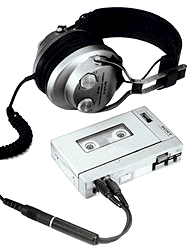Listening to Stereophonic Sound while Walking
By the end of the 1970s,
stereo cassette tape machines
were a cherished fixture in many homes and automobiles. However, truly
portable units with built-in speakers or for use with headphones were
limited to monaural sound.
In 1978, Sony added the small TC-D5 stereo model to its
well-known Densuke series of portable tape recorders. Although popular
among audiophiles, the TC-D5 was too heavy to be truly portable and the
cost was prohibitive
at 100,000 yen.
Ibuka (then Honorary Chairman) was a regular user of the
TC-D5, and he would take one with a set of headphones on overseas
trips, so that he could listen to music in stereo on the plane.
However, he found it too heavy. One day, before going on atrip to the
United States, he asked Ohga (then Executive Deputy President) for a
simple, playback-only stereo version
of the Pressman, the small, monaural tape recorder that Sony had
launched in 1977. Ohga immediately
called Kozo Ohsone, general manager of the Tape Recorder Business
Division.
Ohsone immediately replied, Yes, yes, I'll do it. He had
his staff alter a Pressman, removing the record function and converting
the machine to produce stereo sound. They then attached headphones and
tried this creation. The resulting sound was actually quite good.
Shortly after,
Ohsone and his staff were working on this rather strange-looking
combination of large headphones and a small Pressman, when Ibuka
visited them to discover if theyhad created what he requested. Always
interested in products under development, Ibuka had a habit of dropping
in at Sony's various laboratories.

A prototype with large headphones. >>>
Ohsone suggested that
Ibuka try the modified Pressman.
Ibuka was pleasantly surprised by the powerful sound that came from
such a small device, and he was reminded of the first time he had
listened to stereo sound through binaural headphones at the 1952 Audio
Fair in the United States.
Ohsone managed to provide a modified version of the
Pressman in time for Ibuka's business trip, but it worked with small,
special batteries. Ohga presented Ibuka with the unit, together with
two batteries thathe had an engineer from Ohsone's group rush around
Akihabara (an electronics-shopping district in Tokyo) to find and a
selection of classical music tapes.
Ohga's relief was short-lived. He received a call from
Ibuka in the U.S., who said, The batteries ran out on the plane, and I
can't find any replacements over here. Ohga also realized that the
tapes he gave Ibuka were blank, and he hurriedly called CBS Records in
the U.S. to ask them to prepare a selection of music tapes for Ibuka.
Despite all this, when Ibuka returned from the U.S. he was
obviously pleased with the unit, even if it had large headphones and
lacked a record function. Ibuka went to Morita (then Chairman) and
said, Try this. Don't you think a stereo cassette player that you can
listen to
while walking around is a good idea? Morita took it home to try over
the weekend, and he was also impressed. He agreed with Ibuka that the
sound was quite different compared to conventional speakers, and he was
excited by the fact that the device could be carried around easily,
creating a personal listening experience. Morita's business acumen
alerted him to the great potential of this new item.
Morita & Ibuka from Sony about headphones
Morita was completely absorbed in
the new business. While
Ibuka was adept at spotting new and interesting technologies and
motivating his staff to develop them, Morita was the one who had the
vision required to turn technologies into products. Since the founding
of Sony, the two men had combined these different, but complementary,
talents to great effect.

Morita said to Ibuka, This product is going to enable young people to
listen to music anytime, anywhere. But the headphones are bigger than
the device itself. Can't we do something about that? On hearing that,
Ibuka remembered an R&D meeting two or three months earlier, at
which there was talk of developing lightweight, open-air type
headphones.
The H-AIR MDR-3 model. -->>>
Sure enough, when he went to the Research Laboratory, he found exactly
what he was looking for. The development of the compact and extremely
lightweight H-AIR MDR3 headphones was virtually finished. While most
conventional headphones at that time weighed between 300 to 400 grams,
the H-AIR headphones weighed just 50 grams. Furthermore, the new
headphone driver units that fitted over the listeners' ears were only
23 millimeters across, much smaller than the 56-58 millimeters that was
normal for the oval-shaped, earmuff type headphones developed
previously. Despite being so small and light weight, the headphones
produced great sound.
The H-AIR headphones were included in the portable stereo project in
March 1979. Between them, Morita and Ibuka had successfully brought
together technologies developed independently by different sections of
Sony.
